Evaluation of Diplomacy, Trade, and International Assistance Coherence in the Europe, Arctic, Middle East & Maghreb Branch, 2017-18 to 2022-23
Evaluation Report
Prepared by the Evaluation Division (PRA)
Global Affairs Canada
October 17, 2023
Table of contents
- Acronyms and abbreviations
- Executive summary
- Program background
- Evaluation scope and methodology
- Findings
- Conclusions
- Recommendations
- Annex A - Methodological notes
- Annex B - EGM Branch background
- Annex C - Case studies
Acronyms and Abbreviations
- ADM
- Assistant Deputy Minister
- BFM
- International Business Development, Investment and Innovation Branch
- CBS
- Canadian-Based Staff
- CETA
- Canada-European Union Comprehensive Economic and Trade Agreement
- CFLI
- Canada Fund for Local Initiatives
- CIDA
- Canadian International Development Agency
- CMM
- Committees for Mission Management
- COP 28
- 2023 UN Climate Change Conference
- CSF
- Client Service Fund
- CSO
- Civil Society Organization
- CSR
- Corporate Social Responsibility
- DG
- Director General
- EDM
- Expert Deployment Mechanism
- EGM
- Europe, Arctic, Middle East & Maghreb Branch
- FIAP
- Feminist International Assistance Policy
- FPDS
- Foreign Policy and Diplomatic Services
- FTE
- Full-Time Equivalent
- GAC
- Global Affairs Canada
- GFE
- Goal Free Evaluation
- HOM
- Heads of Mission
- HQ
- Headquarters
- IFM
- International Security Branch
- LES
- Locally Engaged Staff
- MCF
- Mission Cultural Fund
- MFM
- Global Issues and Development Branch
- MSR
- Management Summary Report
- NGM
- Americas Branch
- OGM
- Asia Pacific Branch
- PFM
- Strategic Policy Branch
- PRA
- Evaluation Division
- PRD
- Evaluation and Results Bureau
- PSES
- Public Service Employee Survey
- SEED
- Scholarship and Educational Exchanges for Development
- TFM
- Trade Policy and Negotiations Branch
- WGM
- Sub-Saharan Africa Branch
Executive summary
This thematic evaluation of the Europe, Arctic, Middle East and Maghreb Branch (EGM) examined coherence from 2017-18 to 2022-23 across 3 main business lines: diplomacy, trade and international assistance. It is the last in a series of 4 geographical coherence evaluations conducted by the Evaluation Division. Its main objectives were to provide an assessment of the extent to which the EGM Branch operated in a coherent manner across business lines and to examine the factors that either fostered or impeded this coherence.
The evaluation found that coherence across business lines in the EGM Branch mostly took place at Canadian missions abroad. It occurred within the framework of mandated joint initiatives, such as the Middle East Strategy and free trade agreements, in which the structure and clarity of objectives and priorities was visible to all involved. In some cases, coherence thinking outside of mandated joint initiatives was undertaken in an ad hoc or responsive manner, most notably through joint events and consultations on specific tasking. Corporate systems for planning and reporting did not support or hinder coherence as they were not used to support coherent work. Planning and reporting remained a siloed activity for all divisions across the branch.
Coherence led to greater effectiveness of Canadian engagement in the regions, including unified advocacy, shared networks and leveraged expertise. The evaluation noted a higher degree of efficiency by reducing duplication and improving product delivery with respect to ministerial briefing notes, memoranda to Cabinet and communication with external partners.
Key factors that supported coherence within the EGM Branch included:
- Leadership: In large part, the success of cross-stream initiatives was determined by the direction and guidance provided by senior management to staff, especially in the context of a mandated initiative. Unless specifically mandated, potential nexus or intersecting initiatives tended to not result in tangible coherence and resulted in ad hoc or responsive coherence. Coherence thinking was identified as a gap in the EGM Branch and was limited to some cross-stream annual planning cycles.
- Joint funding: The presence of funds dedicated to multiple business lines to achieve objectives on complementary activities provided groups with a framework. Pooled funding mechanisms allowed for flexibility in planning necessary for different streams to contribute activities within their designated strengths and areas of focus.
- Communications: Consistent communication through formal and informal channels led to good sharing of information, working relationships and increased team preparedness.
Summary of recommendation
EGM should identify opportunities to create structured processes and operational approaches that build coherence through improved communication and engagement between business lines, at the country or regional level, where appropriate.
Key definitions
Coherence: Coherence is a proactive process that identifies and leverages opportunities between business lines, namely diplomacy, trade, and international assistance. It helps Global Affairs Canada to be more effective, efficient, and impactful on the world stage. Coherence has 3 pillars: coherence thinking, collaboration and coordination.
Coherence thinking: Coherence thinking is an approach used to consider and understand interrelationships between business lines in order to identify opportunities and shared priorities. Coherence thinking can help anticipate and incorporate the perspectives of other business lines, which can be beneficial for strategy, planning and international relationships.
Program background
Background: EGM Branch structure
Humanitarian as an integrated model
The Israel, West Bank and Gaza Division is unique at Global Affairs Canada in that it is the only organizational structure that has integrated humanitarian assistance alongside development within the division itself. In most other cases, Global Affairs Canada’s humanitarian programming uses a centralized approach that is based at headquarters.
EGM Branch organizational structure
The Europe, Arctic, Middle East and Maghreb Branch’s organizational structure is designed to cover its broad regional scope and manage diplomacy, trade, and international assistance. The EGM Branch is responsible for 76 countries/regions through the support of 53 missions, including one multilateral mission. It includes 5 bureaus: European Affairs; Middle East; Maghreb, Egypt, Israel and West Bank and Gaza; the Office of the Senior Arctic Official and DG of Arctic, Eurasian and European Affairs; and Ukraine. The branch oversaw $374 billion in Canadian foreign direct investments (2019), $202 million in international assistance (2020-21), and 119 development projects (2020-21). For information on financial and human resources, refer to Annex V.
The EGM Branch’s organizational structure primarily reflects the integration between trade and diplomacy at the Director level. While development is present in the branch and integrated at this level when relevant, the Middle East Bureau and the Ukraine Bureau are both exceptions to this rule, as these bureaus feature standalone development programming divisions. In these cases, integration across business lines occurs at the bureau level.
Figure 1:
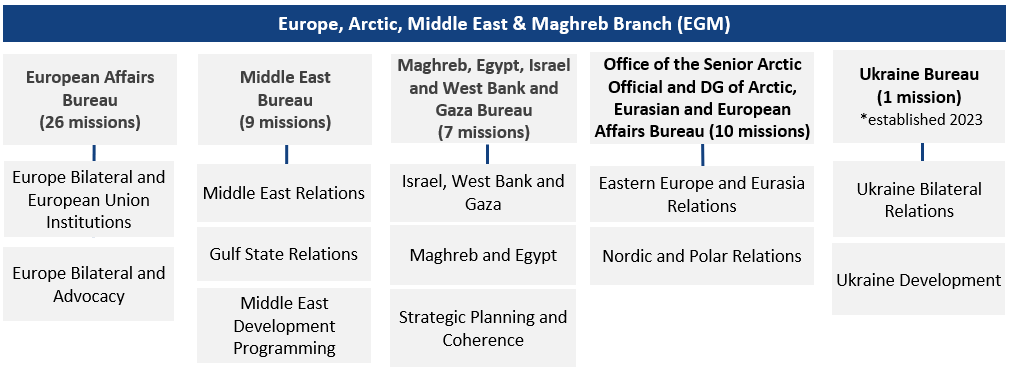
Text version
Organizational structure of the Europe, Artic, Middle East & Maghreb Branch (EGM) chart presenting its bureaus and divisions.
Europe, Artic, Middle East & Maghreb Branch (EGM) includes 5 bureaus which hold 12 divisions:
- European Affairs Bureau (26 missions): Europe Bilateral and European Union Institutions and Europe Bilateral and Advocacy
- Middle East Bureau (9 missions): Middle East Relations, Gulf State Relations and Middle East Development Programming.
- Maghreb, Egypt, Israel and West Bank and Gaza Bureau (7 missions): Israel, West Bank and Gaza, Maghreb and Egypt, and Strategic Planning and Coherence.
- Office of the Senior Artic Official and DG of Artic, Eurasian and European Affairs Bureau (10 missions): Eastern Europe and Eurasia Relations and, Nordic and Polar Relations.
- Ukraine Bureau (1 mission) *established 2023: Ukraine Bilateral Relations and Ukraine Development.
Strategic Planning and Coherence Division
The Strategic Planning and Coherence Division provides fully integrated policy, planning and operational advice and analysis to the EGM Branch. It coordinates planning and reporting for all divisions. It provides consistency in areas such as Planning Commitments, Business Plans, Risk Frameworks, components of Results-Based Management, human resources support, Training, Public Service Employee Survey (PSES) results analysis and strategy, support to missions on position changes, and data analysis and management support.
Evaluation scope and methodology
| Evaluation issue | Evaluation questions |
|---|---|
Effectiveness | Q1. To what extent has the branch put in place conditions that foster coherence among the main business lines? 1.1 What factors influence the branch’s ability to foster coherence? 1.2 To what extent has the branch adopted joint planning, priority setting and coordination of policies and programs across business lines? |
Results | Q2. What are the benefits of coherence efforts in the branch? 2.1 How has the branch’s approach to coherence added value to its international engagement? 2.2 Are there any unintended positive or negative effects of coherence? |
Evaluation objectives
The evaluation objectives included:
- identifying the conditions that enabled policy and programming coherence
- identifying examples of coherence across business lines to achieve greater outcomes
- identifying applicable lessons learned that are related to coherence
Methodological approach
The evaluation was conducted by the Evaluation Division (PRA). It was supported by 2 independent consultants, who carried out a staff survey, and the trade and development nexus case study. The evaluation used a mixed methods approach involving triangulation across multiple lines of evidence. The report has 2 levels of analysis: (1) general insight into coherence within the branch and (2) in-depth analysis of real-world examples of coherence using case studies.
The evaluation took an exploratory approach to its assessment as a result of the dynamic and evolving nature of coherence as a concept. It integrated elements of appreciative inquiry and goal-free evaluation as a way to generate findings (Annex IV). In addition, score cards were given to each organizational factor based on a 3-point scale: impeding, somewhat enabling and fully enabling coherence (Annex III).
The evaluation included an organizational factor framework that built on the work conducted in the previous coherence evaluations (Annex II) and helped generate insights into the conditions that enabled or impeded coherence. The organizational factors include Policy Priority Alignment, Organizational Structure, Leadership, Capacity and Expertise, and Corporate Systems.
Evaluation scope
The evaluation covered the period from 2017-18 to 2022-23. It focused on policy and programming coherence among and between the 3 departmental priorities of diplomacy, trade and international assistance in the Europe, Arctic, Middle East and Maghreb Branch. More specifically, it explored how each organizational factor was leveraged across these priorities, both at headquarters and in the Canadian missions in the region.
While the emphasis of the evaluation was on the activities of the EGM Branch, it also considered the broader scope of Global Affairs Canada programming in the Europe, Arctic, Middle East and Maghreb regions. Where relevant, the scope included activities of multilateral organizations engaged through the Global Issues and Development Branch and security partners linked through the International Security and Political Affairs Branch. This evaluation focused only on elements of internal coherence within the branch.
Methodology
The following details each line of evidence.
Departmental document review
Review of internal Global Affairs Canada documentation:
- policy documents
- planning and strategy documents
- briefing notes and memos
- previous evaluations, audits and reviews
- administrative data including human and financial resources
- select documents from integrated planning and reporting tools, including Strategia
Survey
A survey was distributed to all Canada-based staff (CBS) and locally engaged staff (LES) at headquarters and missions under the EGM Branch, employed in the FS, EC, PM and EX job classifications. Out of a list of 749 EGM employees, 340 employees completed the survey, resulting in a response rate of 45%.
Key stakeholder interviews
A total of 86 interviews were conducted. The majority of interviewees held executive positions. The number of interviewees included:
- 25 at headquarters
- 33 at missions
- 28 case studies
The sample included 14 missions: BRLIN, PARIS, ROME, BREU, BRU, TALIN, ZAGRB, ABDBI, AMMAN, ANKRA, ISTBL, BGRAD, OSLO and KYIV
Literature review
Review of academic literature:
- literature on measuring coherence in policy and programming, organizational development and change management
- literature related to key coherence areas that include at least 2 out of 3 business lines
- open-source data on how other countries undertake policy and programming coherence
Case studies
Two case studies were performed for an in-depth analysis of coherence. In consultations with the EGM Branch, the following case studies were selected:
- The Trade & Development Nexus: Morocco
- The Humanitarian, Development and Peace Nexus: West Bank & Gaza
In-depth case study assessments involved the following:
- 28 key stakeholder interviews
- document and project review
- in-depth analysis of the 5 organizational factors and operational coherence
Coherence pathway mapping
The evaluation team mapped coherence pathways by identifying cross-cutting enablers of coherence that interacted and impacted each of the 5 organizational factors included in the measurement framework.
This pathway mapping identified agents of change, including communication and adaptability, that affected transformation towards increased coherence. These coherence enablers were identified using aggregate quantitative and qualitative data.
Evaluation limitations and mitigation measures
| Limitations | Mitigation measures |
|---|---|
Coherence as an unclear concept Coherence and its associated ideas may not be understood by different employees in the same way. Coherence as a concept is not an end goal and therefore may have different meanings and levels of importance for individuals. This is further reinforced by the use of alternative terms as synonyms, such as consultation, cooperation, and coordination. | Opportunities to define concepts and ensure clarity All interactions with evaluation stakeholders included verbal and written introductions to the concept. Time during interviews was allotted to establishing clear definitions and allowing for questions. Similarly, the survey clearly defined the concept at the beginning. All consultants were provided a briefing on the concept of coherence and provided with the evaluation’s full evaluation matrix and indicators to ensure correct understanding of the unit of analysis for this evaluation. |
Limited availability of administrative and performance data Coherence is not measured within the department, nor are examples and opportunities systematically tracked. Without indicators, administrative and performance data for assessing success in coherent work are scarce, as are attempts to achieve more coherence. As a result, findings are primarily grounded in qualitative data. | Triangulation of available data from multiple sources The EGM Branch documents many of its business processes and there are a number of existing planning and implementing tools that were used. Qualitative evidence was triangulated with administrative data and documentation and across qualitative methods. Scorecards were used to ensure accuracy and consistency across evaluation indicators. |
Emerging and existing international crises The EGM Branch experienced significant pressures during the conduct of the evaluation as a result of the Russian invasion of Ukraine in February 2022 and the February 2023 earthquake in Türkiye. These pressures and changing geopolitical dynamics required the redesign of the scope and case study sample selection. | Redesigned scope and case study sample The evaluation team decreased the number of case studies from 4 to 2 in order to accommodate a reduced evaluation scope. Some interviews originally planned from the sample list were reduced, including part of KYIV and VIENNA. Out of a sample list of 15 EGM countries, 13.5 participated in interviews, for a response rate of 90%. |
Findings
Coherence in EGM Branch: Organizational complexity
Regional priorities
Europe
The EU is Canada’s second-largest trade and investment partner. Commitments include trade and political relations; cooperation on security; and joint membership in the United Nations, North Atlantic Treaty Organization, Organization for Security and Co-operation in Europe, World Trade Organization, and Organization for Economic Co-operation and Development. One of Canada’s top foreign policy priorities is Ukraine.
Circumpolar regions
The Canadian Arctic covers 40% of Canada’s territory. Commitments include addressing climate change, renewing relationships with Indigenous peoples and promoting leadership in Arctic science and research.
Middle East and Maghreb
Canada values the unique historical, linguistic and cultural heritages of these regions. Commitments include promoting peace, stability and economic opportunity.
The complex organizational structure, diverse geographic coverage and regional contextual realities across the EGM Branch were challenges to coherence.
There are several levels of organizational complexity within the branch’s makeup that affected its ability to be coherent across its business lines. The following issues were important:
- separate lines of reporting and accountability
- differing approval and decision-making processes
- priorities defined at headquarters in essentially separate streams that do not identify nexus points
However, geographic coverage was by far the most notable limitation. The EGM Branch has a complex organizational structure featuring 5 geographically assigned bureaus that cover 76 countries and 53 missions. Canadian priorities differ, as does the weight of approach for each line of business.
Organizationally, the interviews made clear that the European Affairs bureau focused on diplomatic and trade efforts, which differed significantly from the Middle East bureau’s approach centred on security and international assistance. This was also observed in the internal planning and reporting documents of the Heads of Mission, which show a marked variation in priorities between the regional EGM bureaus.
In general, only 31% of EGM staff considered that the organizational structure facilitated joint cross-stream initiatives. This proportion is slightly higher at headquarters and among senior managers. In some cases, at both headquarters and missions, physical placement of teams was done in a purposeful manner to foster coherence. The annual planning process was another mechanism where coherence thinking could take place, but according to interview findings, this process remained mostly stream-specific. Almost half (49%) of survey respondents stated that the annual planning process involved the participation of other streams where relevant.
Coherence in EGM Branch: Mandated joint initiatives
Figure 2:
Trade and diplomacy nexus
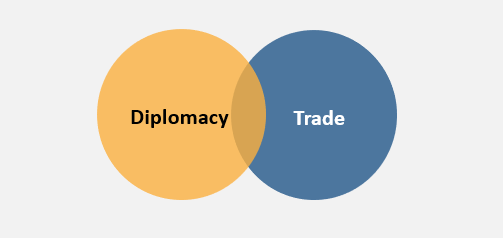
Text version
Trade and diplomacy teams most often coordinated their policies, key decisions and initiatives at the strategic level. Examples of joint initiatives in this nexus include Free Trade Agreements, Commercial Diplomacy and Cultural Diplomacy
Overall, the EGM Branch achieved coherence through mandated and structured joint initiatives that incentivized cross-stream coherence.
For the most part, the evaluation found that the EGM Branch was operating in a coherent manner across diplomacy, trade and development when faced with mandated initiatives. These mandated initiatives presented opportunities for leadership to demonstrate clear messaging about priorities and goals. Mandated initiatives provided a framework for purposeful coherence, catalyzed a “Team Canada” approach and resulted in coordination and collaboration across the department’s business lines. This was demonstrated with the advancement of the Canada-European Union Comprehensive Economic and Trade Agreement (CETA), Canada’s response to the invasion of Ukraine, the Middle East Strategy and priority issues (i.e., energy, cybersecurity, women and girls’ empowerment and human rights).
Mandated initiatives in the EGM Branch demonstrated how overarching Government of Canada priorities facilitated points of convergence or intersection, reaching across ministerial portfolios and departmental streams. To an extent, this was observed in the West Bank and Gaza case study (Annex VIII), where the Government of Canada’s committed goal of a comprehensive, just and lasting peace in the Middle East through a 2-state solution enabled coherence across development and humanitarian business lines. This was contrasted with the Morocco case study (Annex VII), where the Government of Canada did not have a regional or country-focus mandate, thereby leaving each business line to work in a silo and achieve its individual goals.
A priority mandate, such as the ratification of the Canada-European Union Comprehensive Economic and Trade Agreement (CETA), led to cross-stream coherence in order to achieve a common goal on the international stage. In general, the evaluation found that in the case of Free Trade Agreements, trade worked on the specific content of the agreement and collaborated with diplomacy to coordinate advocacy and engagement efforts with local stakeholders to achieve desired outcomes and avoid silo loopholes and inconsistent messaging.
Thematically, the mandate letters of the department’s 3 ministers included certain areas of commonality. These cross-cutting themes were also identified as enabling coherence across business lines. These themes included action on climate change, promoting gender equality and human rights, cultural export and promotion, efforts against COVID-19 and implementation of the Feminist International Assistance Policy, among others. Many of the EGM Branch joint initiatives identified by interviewees and document and project review aligned with these themes. For example, in Norway, the Canadian Embassy team acted on reconciliation efforts and worked to increase the engagement of Canadian Indigenous peoples at a major cultural forum where commercial opportunities also existed, while in the West Bank and Gaza, development and diplomacy collaborated on a joint social media campaign (16 posts in 16 days) and on a joint video for International Women’s Day.
Coherence in EGM Branch: Joint initiatives and collaboration
Figure 3:
Types of joint EGM files or initiatives that led to cross-stream collaboration
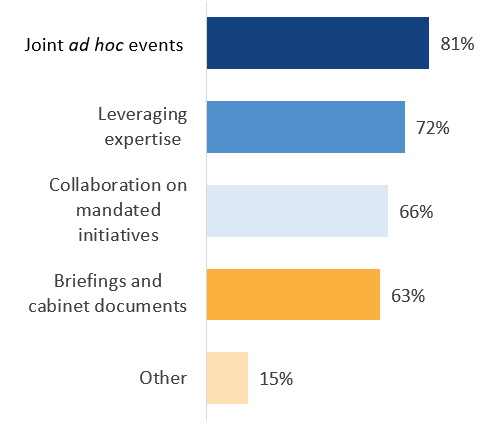
Text version
- Joint ad hoc events: 81%
- Leveraging expertise: 72%
- Collaboration on mandated initiatives: 66%
- Briefing and cabinet documents: 63%
- Other: 15%
* Staff were able to indicate more than one type of joint initiative or files they had been involved in where cross-stream collaboration had occurred. Each category reflects the percentage based on results from all respondents, i.e. versus 100%.
Coherence occurred in an ad hoc manner outside of mandated initiatives, with joint files providing the key vehicle for coherence across business lines.
In the absence of flagship or mandated initiatives, coherence took the form of ad hoc or responsive approaches, leading to more superficial and short-term forms of cross-stream collaboration. In the absence of a mandated initiative, strategic integration of the 3 business lines was (1) not a priority; (2) not operationalized systematically; and (3) not fully understood as a pathway for improved effectiveness, efficiency and impact.
Interviews, document review and survey data showed that some level of collaboration was taking place across business lines. Forums such as Committees for Mission Management (CMMs), working groups, consultations, town halls and team retreats helped establish formal venues to collaborate. Across the branch, diplomacy, development and trade collaborated frequently on 4 main types of joint initiatives, with joint ad hoc events representing the majority of efforts, including joint advocacy events and policy dialogue with partners on topics of shared interest, bilateral relationship anniversaries, official visits and trade shows.
Survey results showed that teams worked on an average of 4.5 joint files over the last 3 years. These included projects and initiatives like responses to crises (i.e., the war in Ukraine, natural disasters, the COVID-19 pandemic), integrated and coordinated approaches for Minister briefings and Cabinet documents, and leveraged expertise and network initiatives (i.e., the United Arab Emirates Defence Trade Show, Canada’s participation in COP 28 in Dubai, the Berlinale International Film Festival and the Venice Biennale for cultural diplomacy). Moreover, the Morocco case study showed that in the absence of a unifying strategy, ad hoc coherence was observed in such examples as Canada Day in Rabat, applications for export permits and the promotion of corporate social responsibility (CSR). A proportion of EGM Branch survey participants (45%) reported to have worked on at least four or more cross-stream initiatives. Executives (68%) reported to have worked on a least four joint files, which was higher than non-executives (42%).
EGM Branch staff across all business lines valued working on joint files across streams but underestimated the value their colleagues place on working together.
Most surveyed staff (87%) recognize the value of collaboration across streams. However, only a slight majority (52%) felt that staff outside of their streams also valued working on joint files. Staff with more direct and regular interaction with other business lines perceived willingness in a more positive manner. Indeed, 74% of executive level staff shared this positive perception, as compared to 47% of non-executive staff. Despite survey results showing that Canada-based staff (91%) and locally engaged staff (85%) both highly valued joint initiatives that included other streams, interviews reflected that information sharing did not always include locally engaged staff. Case studies showed that locally engaged staff’s local knowledge was not always valued or included at strategic points.
Coherence in EGM Branch: Flexibility and adaptability
Figure 4:
Percentage of EGM staff reporting medium or high level of collaboration with other business lines.
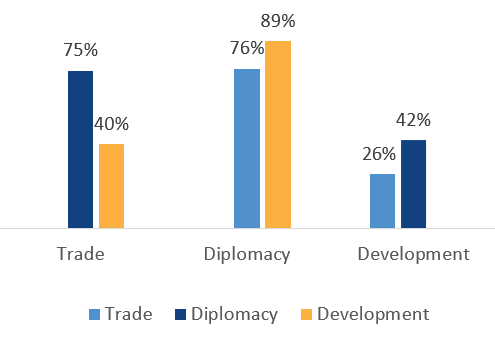
Text version
Trade
Diplomacy: 75%
Development: 40%
Diplomacy
Trade: 76%
Development: 89%
Development
Trade: 26%
Diplomacy: 42%
Staff in each business line had some flexibility to work with others.
The flexibility to work with other streams was measured in order to assess the level of adaptability or rigidity that each business line had with regard to collaborating with others. Contrary to a commonly held belief in the department, the evaluation found that the 3 business lines were in fact flexible and willing to work with one another.
Development, trade and diplomacy had some flexibility to work with other business lines, with 63% of all respondents indicating that they had the ability to tailor proposals for joint initiatives. In cases where flexibility was present, incentives presented by leadership were identified as a factor by 46% of interviewees, while the nature of the file was identified as a factor by 33% of interviewees. Those in the latter group indicated that some issues simply could not be addressed in silos. In these cases, coherent approaches seem to emerge organically (i.e., Canada’s response to the invasion of Ukraine).
The branch’s diplomatic work was central to coherence across business lines.
Coherence was mostly observed at Canadian missions on the ground and in the regions. Two thirds of all survey respondents (regardless of business line and location) agreed that initiatives delivered at missions were coordinated across streams and were undertaken in a relevant way. Staff in both trade and development divisions expressed that diplomacy was the stream they most collaborated with and that teams in the diplomacy stream were more likely to collaborate across business lines than those in trade or development streams. Interviews and case studies both validated diplomacy’s central role in fostering coherence, highlighting the importance of advocacy efforts and bilateral relationships with local governments and partners in this regard.
Collaboration between trade and diplomacy was essential to ensuring Canada’s positioning, playing a key role in supporting Canadian exporters, ensuring their place in various markets and advancing free trade agreements such as the Canada-European Union Comprehensive Economic and Trade Agreement (CETA). Meanwhile, development was found to leverage diplomacy’s advocacy of human rights and women’s empowerment under the Middle East Strategy.
The West Bank and Gaza case study demonstrated the importance of diplomatic work. In this case, all streams confirmed communication products through the diplomacy stream, thereby ensuring the proper representation of Canada's goals and maintenance of essential bilateral relationships with all stakeholders to continue work in the region.
Coherence in EGM Branch: Strategy and policy alignment
Strategy vs Planning
Effective strategies have long-term vision and try to understand the “why”, whereas planning exercises are the operational application of “how” a strategy will be achieved.
The EGM Branch lacked strategies to anchor its work and interpreted coherence as an annual planning exercise.
In general, coherence thinking, or the ability to strategically consider, anticipate and incorporate the positioning of other business lines, was for the most part associated with and left to the annual planning process in the EGM Branch. Interviews and document review showed that the development of a strategy was conflated with the implementation of an annual planning exercise. Interviewed branch staff believed that strategic coherence should only be considered once a year as part of the department’s corporate planning exercise.
There was an absence of regional strategies to ground planning and work across the branch, with some rare exceptions. These included the Middle East Strategy—which is primarily focused on development assistance, peace and security priorities—and Canada’s response to the invasion of Ukraine. These 2 strategies helped in identifying cross-stream opportunities and priorities, where business lines could more purposefully and effectively anticipate and incorporate the perspectives of other business lines. Outside of these 2 strategies, business lines in each of the 4 main regions of the branch (Europe, Arctic, Middle East and Maghreb) were left to approach coherence without a strategic vision. In the absence of regional strategies and mandated initiatives, coherence was ad hoc across business lines, resulting in missed opportunities.
The lack of regional strategies also appeared to compound challenges in managing the branch at the broadest level. With a complex organizational structure, multiple high-level crises, and flagship initiatives, priority setting was reactive and resulted in some regions being overlooked by senior management, including the Maghreb. Interviews with the branch’s management identified regional strategies as an opportunity to have more effective and coordinated management of regionally specific priorities. Country frameworks have also facilitated the identification of coherence points across business lines.
The Feminist International Assistance Policy supported coherence.
The Feminist International Assistance Policy was a cross-cutting guiding policy that enabled coherence between development, humanitarian, peace and stabilization, and diplomacy, in addition to fostering coherence between trade and development. Both case studies demonstrated a nexus approach, according to which streams were able to increase coherence based on thematic programming and initiatives. In the West Bank and Gaza, the Feminist International Assistance Policy was well aligned with local needs, including economic growth and gender rights. In Morocco, the Feminist International Assistance Policy provided the opportunity for coherence in the absence of a regional strategy or mandated priority. Here, leadership chose to use the policy to establish a unifying vision across streams, thus creating a common thread for programming and activities focused on gender empowerment. The Head of Mission, development, diplomacy and trade included gender equality in their initiatives.
Coherence in EGM Branch: Corporate systems
Figure 5:
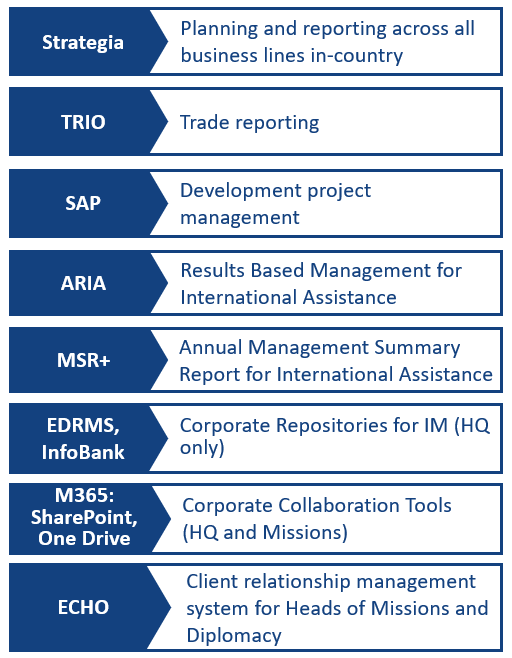
Text version
- Stategia: Planning and reporting across all business lines in-country
- TRIO: Trade reporting
- SAP: Development project management
- ARIA: Results Based Management for International Assistance
- MSR+: Annual Management Summary Report for International Assistance
- EDRMS, Infobank: Corporate Repositories for IM (HQ only)
- M365: Sharepoint, One Drive: Corporate Collaboration Tools (HQ and Missions)
- ECHO: Client relationship management system for Heads of Missions and Diplomacy
Corporate systems did not facilitate coherence within EGM branch.
Many survey respondents (57%) indicated that planning and reporting systems adequately supported strategic planning and reporting within their business stream. However, a much lower number (29%) felt that these systems supported integrated planning and reporting across streams. Interviews demonstrated that the department’s corporate systems were not equipped to translate and transmit information across platforms. Staff from each business line were unable to access or interpret data across the multiple planning and reporting systems in use. Certain systems, such as MSR+ and TRIO, were used by development and trade programs specifically and were not available to individuals outside of the stream. SharePoint and Teams came into use towards the end of the evaluation period and were generally appreciated and perceived as contributing to greater coherence. Interviews and survey respondents indicated that new digital tools had enabled collaboration through easy access to remote meetings and their broader reach. SharePoint’s use across the branch is not uniform. A recent roll out of ECHO, a new client relationship management system for Heads of Mission and the diplomacy stream, has yet to show results with regard to enabling coherence across business lines.
While the Strategia system was not generally seen as enabling coherence, it did support the planning process and was considered the best among the tools that existed, allowing information from the different streams to be in the same place and creating links between headquarters and missions. However, interviewees expressed that what most promoted coherence were initiatives like retreats and team-building exercises rather than the Strategia tool itself. In formulating critiques of the Strategia tool, respondents mentioned that it lacked connectivity with other corporate systems, that it was too cumbersome to use and that the ability to link streams and initiatives was lacking in the system. Also, some people felt that it was mostly a “checkbox exercise.” Overall, Strategia was used as a reporting and accountability tool rather than as a coherence enabling tool.
Although the evaluation observed that there were multiple repositories (i.e., EDRMS, InfoBank, I-drive) impeding effective information sharing across streams, there was insufficient data across interviews, survey data and case studies to demonstrate that they impeded coherence.
Coherence in EGM Branch: Capacity - HR and prioritization
“It’s an added challenge, as an FPDS stream specialist coming into a management role, suddenly having the responsibility for trade and development. There should be a package of training for management so they know what it means, concretely, to think coherently about the streams.”
Figure 6:
Ratio of the # of corporate taskings per # of CBS employees by geographic branch
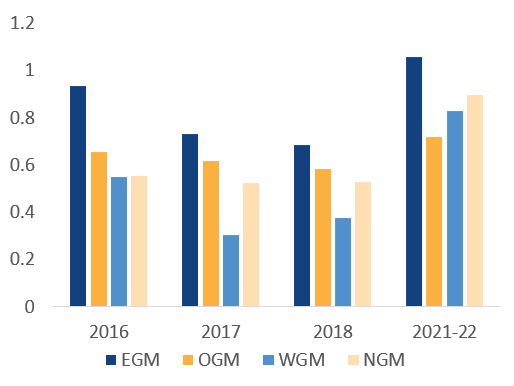
Text version
2016
- EGM: 0.93
- OGM: 0.65
- WGM: 0.55
- NGM: 0.55
2017
- EGM: 0.73
- OGM: 0.62
- WGM: 0.31
- NGM: 0.52
2018
- EGM: 0.68
- OGM: 0.62
- WGM: 0.38
- NGM: 0.53
2021-22
- EGM: 1.06
- OGM: 0.72
- WGM: 0.83
- NGM: 0.90
Staff capacity to undertake coherent work was challenged by limits to time and a high degree of urgency in core responsibilities.
Many missions, both large and small, presented human resources capacity and workload pressures as a key risk to meeting coherence objectives and work-life balance. While some of the work of the geographic branches is simply reactive by nature, the resource pressures in the EGM Branch exacerbated this issue and increased the demands on staff. Time and resources were limiting factors for coherence both at headquarters and missions. Interviews and document review confirmed that the tempo and reactive nature of the work across the EGM Branch resulted in coherence not being a priority, both for leadership at HQ and the non-executive level. This was particularly evident in work undertaken in high-profile mandated initiatives such as the Middle East Strategy and efforts in Ukraine.
Resource pressures, including the number of staff available to respond to the branch’s high demands, were presented as a risk in EGM Branch Business Plans from 2017-18 to 2022-23. At the HQ level, the business plans stated that HQ faced pressures due to a high percentage of rotational and mobile staff (83%) and a low proportion of at-level indeterminate staff. In 2019-20, 34% of headquarters’ full-time employees were indeterminate at-level employees and 41% were either non-indeterminate or the positions were left vacant. There was an overreliance on term and contract staffing, and high turnover and vacancies resulted in inexperienced staff and pressures on management with regard to training, loss of corporate knowledge and an increased burden of recruitment of qualified candidates. 2018 Public Service Employment Survey (PSES) results showed that a significant number of employees (42%) did not feel they could complete their workload during regular working hours. This was significantly higher than the rest of the department (24%). In comparison to other geographic branches, EGM has one of the highest ratios of both missions and countries to Canada-based staff employees. EGM is also the geographic branch with the highest ratio of corporate tasking (memos, briefing notes and briefing books) to Canada-based staff employees.
Coherence in EGM Branch: Capacity - Experience and training
Cross-stream experience and increased awareness and understanding of the work of other business lines facilitated coherence.
Where it existed, cross-stream experience increased employees’ awareness and understanding of the work and priorities of other business lines. One third of interviews (33%) noted that cross-stream experience facilitated coherence thinking and coordination. A significant number of survey respondents also provided unprompted input about the need for greater understanding of the work of other streams, with 35% of all open-ended survey responses referencing this need. The evaluation found that an average of 44% of EGM staff indicated having previously worked in other business streams, with development having the most experience (54%) and trade the least (43%). Respondents suggested solutions such as cross-stream experience, job shadowing, short assignments and training opportunities.
Despite the identified value it brings, there was an apparent lack of cross-stream experience and knowledge across EGM staff and management, which was identified by interviews and survey results as a barrier to coherence. The departmental human resources structures and processes in place were seen as an impediment to gaining this type of valuable experience.
Learning programs existed to support management and staff in the development of coherence thinking in the absence of coherence-specific training.
The department does not offer coherence-focused training. The training that did exist was specific to business line issues and opportunities, such as development assistance collaboration, trade and diplomacy. These training sessions did not provide guidance or access points for understanding priorities and opportunities within the other business lines, nor did they indicate how to identify convergent or nexus points.
Several survey respondents (40%) stated that they had participated in professional development opportunities to help them gain experience in nexus areas, and 78% felt they had the skills to work with colleagues across streams. Other interviewees (29%) explained that there were stream-specific and more general training opportunities that provided building blocks for future cross-stream collaboration. These included Foreign Policy and Diplomatic Services, Trade and Consular 101 courses and program manager training in which inter-program collaboration was promoted. In addition, corporate reporting tools such as Strategia focused on training to support the annual strategic planning process and included information on coherence. Some Heads of Mission specifically referred to this training as a source of guidance for applying coherence at missions. Lastly, a limited number of staff across the branch participated in a pilot Triple Nexus-focused training centred on development, humanitarian, and peace and security, and which is currently being redesigned by the Canadian Foreign Service Institute.
Coherence in EGM Branch: Missions and headquarters
Figure 7:
Roles and responsibilities for coherence
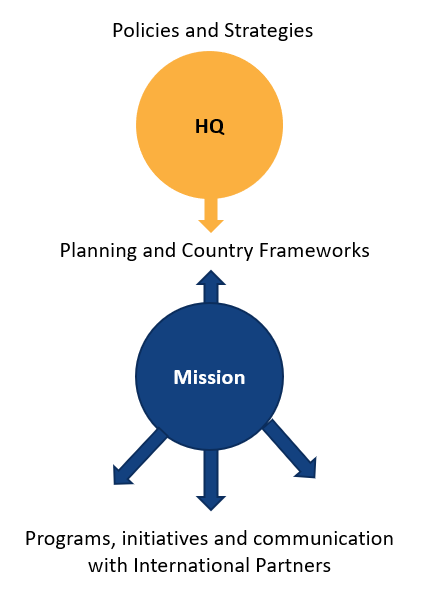
Text version
Visual representation outlining interactions between:
- Policies and Strategies
- HQ
- Planning and Country Frameworks
- Mission
- Programs, initiatives and communication with International Partners
Missions displayed higher levels of coherence across streams compared to headquarters.
Organizational coherence was most clearly observed at missions where coordination between streams required more attention due to direct interaction with international partners, and where a coherent approach was more actively practiced. Missions identified this as the “Team Canada” approach, a term normally used to identify trade missions but increasingly employed to refer to the full efforts of a mission. Document review confirms that Heads of Mission were the Government of Canada’s public face with national authorities for all in-country programs and activities. The “Team Canada” approach at missions was highlighted through cultural diplomacy, such as the Berlinale International Film Festival and the Vienna Biennale, and commercial diplomacy, such as the United Arab Emirates Defence Trade Show. Additionally, smaller Canadian missions were more successful in achieving coherence as a result of (1) staff working more closely together, and (2) in some cases, the same person being responsible for files across several business lines, resulting in increased levels of information sharing and the discussion of strategic cross-stream considerations (missions in Ramallah and Tallinn). By necessity, these situations contributed to increased coherence. Conversely, the business lines of larger missions (35+ staff) were found to be more isolated in their work. At headquarters, staff played a different role with regard to the “Team Canada” approach, where each stream interacted directly with missions as opposed to interfacing with international partners. The role and responsibility of HQ had more to do with the development of policies and strategies, which then enhanced coherence at missions.
The influence of Heads of Mission was critical to achieving coherence.
Interviews and case studies demonstrated the significance that Heads of Mission have with regard to fostering coherence. Following the amalgamation of the Department of Foreign Affairs and International Trade with the Canadian International Development Agency, Heads of Mission (HOM) and Deputy Heads of Mission (DHOM) played a central role as integrators of all programs at their respective missions. They ensured policy and programming coherence to achieve greater program effectiveness and impact. Performance Measurement Agreements take into account the Heads of Missions’ enhanced role for overall country policy and programming coherence and integration across all business lines. Some examples in which HOMs and DHOMs championed coherence, identified coherence points and provided tangible guidance on operational coherence were observed at the Ramallah, Rome and Paris missions. They included identifying nexus or intersection points, providing guidance on joint initiatives and incentivizing coherence. Supported by this type of leadership, program managers at missions played pivotal roles in enabling coherence. This was the case in the West Bank and Gaza case study, where development and humanitarian program managers fostered coherence as part of their day-to-day work, for example, by coordinating with external partners, carrying out joint field visits and sharing information and discussions about gender-based violence projects.
Factors for coherence: Leadership
Figure 8:
Perception that coherence is a priority for senior management in EGM.
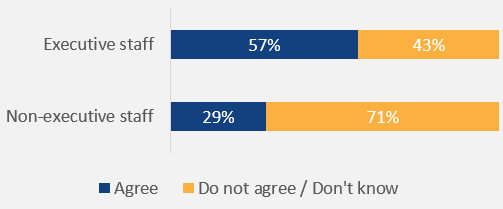
Text version
Executive staff
Agree: 57%
Do not agree/ Don’t know: 43%
Non-executive staff
Agree: 29%
Do not agree/ Don’t know: 71%
Figure 9:
Perception that senior management provide staff with guidance for coherence thinking.
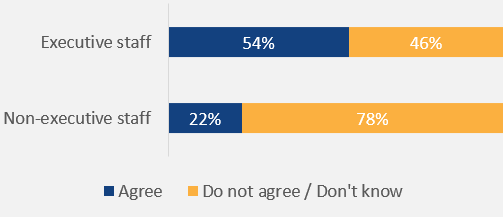
Text version
Executive staff
Agree: 54%
Do not agree/ Don’t know: 46%
Non-executive staff
Agree: 22%
Do not agree/ Don’t know: 78%
Senior management at HQ played a key role in strengthening coherence.
The presence of strong leadership and vision on coherence was a key enabling factor, with 67% of interviewees highlighting the importance of senior management in fostering coherence. Interviews and the West Bank case study highlighted that senior management at HQ fostered an atmosphere of collaboration across business lines. The vision, encouragement and priorities of management at HQ were seen as the main motivators for employees to advance coherence. Where leadership messaging and vision were absent, coherence was also less evident. The evaluation also found that not only did leadership at HQ provide motivation, it also diminished or even eliminated the constraints caused by a complex organizational structure.
Despite the importance of leadership for coherence, only 29% of non-executive survey respondents perceived that coherence was a high priority for senior management, while 57% of executive respondents felt that it ranked high in importance. Similarly, 71% of interviewees did not perceive coherence as a priority for their management. Only 22% of surveyed non-executive staff felt that senior management provided staff with the necessary guidance to engage in cross-stream collaboration, as compared to 54% of executives. There were no or very limited formal or informal incentives at the non-executive level for prioritizing coherence.
Members of the EGM Branch’s senior management with experience across business lines or coherence knowledge demonstrated greater openness to coherence.
As previous coherence evaluations demonstrated, leadership plays a key role in enabling coherence. The executive level employees (Directors, Director Generals and Assistant Deputy Minister) in the EGM Branch with either previous experience working within a different business line or with coherence knowledge and applicable tools at their disposal, such as working groups and coordination meetings, were better at providing tangible and operational guidelines to their teams for coordinating across business lines. In the West Bank and Gaza case study, leadership at HQ demonstrated previous experience and knowledge of operational coherence. As a result, they were able to provide guidance and mechanisms that incorporated a strategic 5-year planning exercise, which identified nexus points that included both HQ and missions and involved multiple business lines (diplomacy, development and humanitarian).
The evaluation also found that not all senior management was equipped with the skills or tools to identify coherence points or provide tangible guidance for operational coherence, resulting in a coherence gap. Leadership’s ability to comprehend operational coherence, identify nexus points and communicate these to staff effectively was not evident in either of the evaluation’s 2 case studies.
Factors for coherence: Flexibility and communication
Figure 10:
Perception of flexibility to adapt to proposals from other business lines by stream.
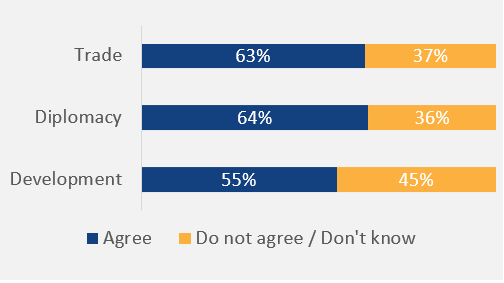
Text version
Trade
Agree: 63%
Do not agree/ Don’t know: 37%
Diplomacy
Agree: 64%
Do not agree/ Don’t know: 36%
Development
Agree: 55%
Do not agree/ Don’t know: 45%
The presence of joint funding facilitated cross-stream flexibility and increased coherence across business lines.
There were some cross-stream funding mechanisms that supported joint initiatives, such as the Canada Fund for Local Initiatives (CFLI), which supported foreign policy goals through small investments from the International Assistance Envelope, and the Expert Deployment Mechanism (EDM), which provided international assistance funding to support capacity development and technical assistance for both trade and development objectives. Information collected through interviews also showed that other funds, such as the Client Service Fund (CSF), Integrative Trade Strategy Fund (ITSF), Scholarship and Educational Exchanges for Development (SEED) and the Mission Cultural Fund (MCF), also contributed to cross-stream coherence but had narrower business line-specific criteria. In fragile and conflict contexts, management interviews indicated the Government of Canada Crisis Pool funding mechanism was one of the fundamental enablers of flexibility across streams in urgent, uncertain and volatile contexts, such as the 2022 earthquake in Türkiye and Canada’s engagement in the West Bank and Gaza.
Communication and adaptability are cross-cutting enablers.
Open and consistent communication through formal and informal channels led to good sharing of information, working relationships and increased team preparedness, particularly when (1) middle management coordinated expectations and approval processes, (2) staff consulted across streams and included local knowledge (i.e., LES), and (3) information sharing was open and transparent, as identified by interviews and case studies. When communication did not occur, levels of misunderstanding and confusion increased, impeding coherence.
In the context of addressing emerging complex issues, such as the invasion of Ukraine and the May 2021 conflict in the West Bank and Gaza, the ability to adapt was observed as an enabler to coherence. This adaptability was a result of efficient assessments and responses where streams leveraged expertise and networks. Adaptability was also observed in innovative approaches to the trade and development nexus, specifically in the areas of climate, environment and water diplomacy. This was observed in the West Bank and Gaza case study and in the climate finance work of trade commissioners.
Incentives for coherence were welcome yet lacking in the EGM Branch.
Interviews, survey, document review and case studies showed that there were no or very limited formal or informal incentives to encourage coherence. Survey data showed that only 18% of EGM staff perceived that incentives for cross-stream collaboration existed (i.e., career promotion, awards, recognition, etc.). On an individual level, Performance Measurement Agreements were a starting point, but incentives that go beyond this could be more effective and create a culture change towards greater coherence across business lines.
Impact of coherence
Key impacts of coherence
- Team Canada (unified voice and messaging to external partners is coherence across streams)
- Canadian leadership (increased exposure, visibility and reputation)
- Increased knowledge of other streams.
- Greater collegiality, including increased mutual appreciation, support, trust and respect.
Coherent approaches contributed to increased efficiency and effectiveness.
Coherence helped missions across the branch support Canadian objectives by promoting a “Team Canada” approach, such as Canada’s participation in COP 28 in Dubai. Surveyed trade and diplomacy staff largely agreed (70%) that other business streams’ contributions on joint files led to increased efficiencies in project and policy implementation. These efficiencies included reducing duplication and improving product delivery (i.e., ministerial briefing notes, memoranda to Cabinet and communication with external partners). Surveyed development staff also agreed, though by a smaller margin (54%).
In addition, cross-stream collaborations resulted in more coordinated approaches with external stakeholders. For example, trade and diplomacy had uniform messaging and advocacy when advancing the Canada-Europe Trade Agreement. When applied, coherent approaches were also found to increase the strength and credibility of Canada's leadership. For instance, the West Bank and Gaza case study demonstrated that coherent approaches resulted in a strong and capable reputation of engagement in the region, where Canada was able to demonstrate global leadership by being assigned the role of Co-Chair of the Good Humanitarian Donorship group with the European Civil Protection and Humanitarian Aid Operations group in order to ensure donor coordination.
A large proportion of EGM staff (79%) agreed that the contribution of other streams was instrumental in achieving project results on a joint file. This importance was greatest for the development stream, at 92%. Examples mentioned by interviewees include the advancement of the Canada-European Union Comprehensive Economic and Trade Agreement (CETA) and cultural diplomacy (i.e., the Berlinale International Film Festival). Increased effectiveness resulted from unified advocacy, shared networks and leveraged expertise.
Key informant interviews, survey results and case studies also showed that cross-stream efforts allowed for different perspectives and offered more comprehensive solutions, products and delivery of events, such as official visits. The quality of deliverables increased while gaps and strategic oversights that often result from working in silos were reduced. For example, in the West Bank and Gaza, coherence between diplomacy, humanitarian, development, and peace and security were essential to delivering programming and managing security. A review of project documents and interviews showed that joint committees, strategic workshop meetings and coordinated communication contributed to both efficiency and effectiveness when addressing issues such as settler violence and food security, as well as running social media campaigns.
Coherent approaches allowed staff to have a better understanding of other business lines.
Collaboration between streams gave 89% of survey respondents the opportunity to increase their understanding of other streams and 82% the ability to acquire new skills and expertise. For example, in the West Bank and Gaza, development and diplomacy increased the respondents’ knowledge of humanitarian principles.
Conclusions
Conclusions: Europe, Artic, Middle East and Maghreb Branch
Leadership was vital to coherence and most impactful on the ground where the connections between business lines were most visible and needed.
Coherence required strong leadership in the branch, with those most involved in the implementation and impact of these efforts situated at Canadian missions across all 4 regions of the branch. Despite the fact that staff across the branch valued and took an interest in coherence, leadership was needed to materialize this into joint efforts. While executive level HQ staff with previous cross-stream experience, coherence knowledge and applicable coherence tools at their disposal were better equipped to provide tangible and operational guidelines to their teams, Heads of Missions were a key point of convergence for business lines in the branch.
Mandated joint initiatives provided the framework needed for coherence.
The evaluation found that the EGM Branch was operating in a coherent manner across diplomacy, trade and development when there was a mandated priority. This facilitated clear messaging from leadership about priorities and goals, catalyzing a “Team Canada” approach. Mandated priorities provided a purposeful framework and served as one of the only identified incentives for coherence in the branch. In the absence of a mandated priority, coherence took an ad hoc or responsive approach, with joint files and efforts providing the key vehicle for coherence across business lines. These ad hoc approaches to coherence were highly dependent on leadership, capacity and expertise, including cross-stream experience and knowledge of coherence among both executive level and non-executive level staff. While in some cases, the responsive approach to coherence was appropriate, an overall ad hoc approach to coherence was less efficient and made it possible for repetition to occur, while also making it more difficult to understand the impact of the branch’s engagement.
Priority and planning exercises were more effective when guided by a regional strategy.
In the presence of regional strategies that set clear expectations of partnerships, shared outcomes and priorities, planning exercises resulted in more effective and efficient coherence. However, regional strategies that had long-term vision and provided purpose were relatively uncommon in the branch. In their absence, annual planning exercises were used to implement short-term approaches. In the EGM Branch, strategy and planning were seen to be interchangeable and mistakenly understood to mean the same thing.
Although the EGM Branch implemented annual planning exercises, these were mostly business-line specific rather than integrated exercises across business lines. Priority setting in the branch demonstrated quick and adaptable approaches to changing circumstances but also showed that some regions did not have a unifying vision for their priorities, resulting in business lines working more in silos.
Conclusions: Across four geographic coherence evaluations
Intentional effort and formal frameworks incentivized and increased collaborative success across business lines.
In all 4 geographic branches, the evaluation pointed to limited integrated planning and coherence thinking across business lines, which made coherence less purposeful and effective. This was further compounded by limited availability of regional strategies, country frameworks and joint funding mechanisms to support cross-stream initiatives.
The evaluation identified how regional strategies positively impacted the ability to identify opportunities across business lines when these strategies were present, resulting in more purposeful coherence and greater effectiveness. In addition, the integration of systemic monitoring and evaluation of coherence was identified as being important for finding gaps and improving coherence in order to allow business lines to more effectively address complex global challenges.
Effective communication led to more coherence across business lines.
The evaluation series further emphasized the need for transparent communication channels to support cross-stream opportunities. The primary responsibility for articulating coherence within these opportunities lay with Canadian missions across the globe. While senior branch management across the department understood coherence across business lines as being important, staff in all geographic branches were not always aware of this importance. Messaging, guidance and mechanisms to operationalize coherence were not effectively disseminated to the working level. Some best practices included the establishment of coherence champions or committees, town hall meetings and¸ newsletters. Staff and management with experience working across different business lines were much more ready to consider and work towards joint objectives. The harnessing of these focal points and the creation of virtual spaces were also identified as best practice.
Experience and knowledge sharing were essential for identifying nexus points across business lines.
In the absence of strategies and mandated initiatives, coherence was left to the ad hoc responsive efforts of individual leaders and staff across all geographic branches, despite findings that illustrated the negative impact of this approach on the efficiency of activities. Training or opportunities to learn more about coherence and its importance were lacking across all geographic branches. Best practices and lessons learned about coherence were not converted into explicit knowledge or shared across the department, including the dissemination of case studies and examples of successful joint initiatives.
Recommendations
EGM should identify opportunities to create structured processes and operational approaches that build coherence through improved communication and engagement between business lines, at the country or regional level, where appropriate.
*Consideration for all geographic branches
As the fourth and final in a series of coherence evaluations, this evaluation reinforces findings and conclusions that are relevant for all geographic branches. This evaluation proposes for consideration the development and integration of regional frameworks to enable coherent action for the Africa, Americas, and Asia Pacific branches.
Annex A - Methodological notes
Annex I: Emergence of a stable coherence measurement framework
The measurement of coherence has evolved based on lessons learned from 3 previous evaluations, including the Sub-Saharan Africa (WGM), the Americas (NGM) and the Asia Pacific (OGM) branches that were evaluated between 2017 and 2022.
1. Approach for the Sub-Saharan Africa Branch
This first evaluation of coherence was a learning opportunity and highlighted the challenge of defining coherence and measuring its contribution to improved results across diplomacy, trade and international assistance. The evaluation assessed the degree to which key elements of organizational coherence (Policy alignment, Organizational structure, Branch leadership, Corporate systems, Roles and responsibilities, and Communication) were in place within the branch to enable effective coordination and collaboration across business lines.
The evaluation identified 4 key coherence areas across business lines: diplomacy-trade, diplomacy-international assistance, trade-international assistance and diplomacy-trade-international assistance.
The identification of cross-stream initiatives was not the main focus of the evaluation, which led to limited examples of joint initiatives.
2. Approach for the Americas Branch
Building on the work of the first evaluation, this evaluation focused on the 4 coherence areas (e.g., diplomacy and development) identified in the Sub-Saharan Africa Branch, with a particular focus on 3 issues: coherence in programming and results, organizational coherence and delivery models to strengthen coherence.
The evaluation developed a scorecard to assess organizational coherence factors (Policy alignment, Organizational structure, Branch leadership, Corporate systems, and Communication). The definition of coherence was updated.
Efforts were made to document cross-stream initiatives and therefore assess whether coherence was being achieved.
3. Approach for the Asia Pacific Branch
The third coherence evaluation has refocused on the key organizational factors and conditions that enabled policy and programming coherence (Policy alignment, Organizational structure, Branch leadership, Corporate systems, and Capacity and expertise). Coherence factors have been streamlined by removing 2 factors to address lessons learned from the Americas coherence evaluation. One new factor was added: Capacity and expertise. The Measurement Framework for the organizational factors has been revised and updated to include new indicators to measure each factor. This new framework features an updated concept of coherence, which now includes two principal dimensions: collaboration and coherence thinking. Coherence with other branches was also explored.
Cross-stream initiatives have been systematically identified and new indicators were used to assess whether coherence was being achieved.
Annex II: Organizational factors
A measurement framework
The evaluation established a measurement framework, consisting of five organizational factors, that was used as component of the Evaluation of Coherence in the Europe, Arctic, Middle East & Maghreb Branch: Diplomacy, Trade and International Assistance.
Figure 11:

Text version
Icons representing: Policy Alignment, Organizational Structure, Branch Leadership, Capacity and Expertise and Corporate Systems.
Five organizational factors
Five organizational factors were identified as elements that enable coherence. These are policy alignment, organizational structure, leadership, capacity & expertise, and corporate systems. Each factor features multiple dimensions.
It should be noted that while a degree of maturity in each area is a necessary condition for coherence, it may not be sufficient. Other factors, including those external to the branch and out of its control, may impede coherence. As such, this rubric was used in conjunction with other lines of evidence to provide a more comprehensive assessment of coherence within the branch.
Evolution of the organizational factors
Organizational factors were used as an assessment tool in the 2 previous evaluations of policy and programming coherence:
- WGM/Sub-Saharan Africa: laid the foundation for coherence, including providing a definition that has been used across evaluations and a scorecard methodology.
- NGM/the Americas: slightly refined the factors overall and focused primarily on the factor of organizational structure.
- OGM/Asia Pacific: built upon the understanding and expertise developed in the first 2 evaluations of coherence to further refine the factors and their respective indicators.
- EGM / Europe, Arctic, Middle East & Maghreb refined the indicators measured under each factor.
Annex III: Scorecards for the Europe, Arctic, Middle East & Maghreb Branch (EGM)
In parallel to previous coherence evaluations (WGM, NGM and OGM), scorecards were designed to assess each of 4 organizational factors, taking into account their respective indicators. Scores given to each organizational factor were determined based on document review, survey responses, and key informant interview analysis.
Each scorecard includes the definition of each factor, along with the scale and definition of the 3 potential scores. Lastly, the score for each element is indicated in blue.
Note that the factor corporate systems and tools was not scored, as it was found to neither enable nor impede coherence in the EGM Branch.
Figure 12:
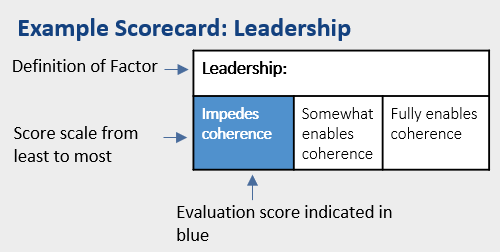
Text version
Example Scorecard: Leadership
Figure 13:
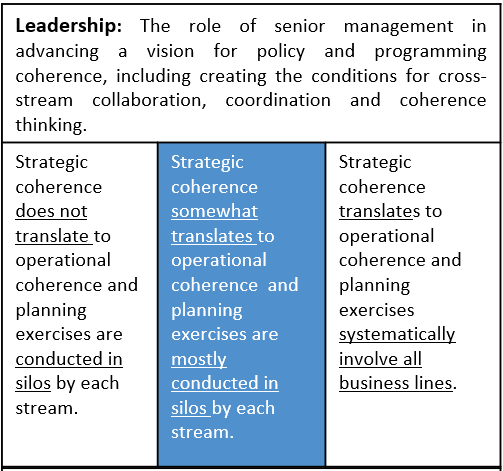
Text version
Presentation of a scorecard: Leadership
Leadership: The role of senior management in advancing a vision for policy and programming coherence, including creating the conditions for cross-stream collaboration, coordination and coherence thinking.
Strategic coherence somewhat translates to operational coherence and planning exercises are mostly conducted in silos by each stream.
Figure 14:

Text version
Presentation of a scorecard: Organisational Structure.
Organizational Structure: The lines of reporting, roles and responsibilities, and formal and informal coherence mechanisms that enable Branch operations at headquarters and at mission.
Some aspects of organizational structure (flexibility, approval, consultation and decision making processes) somewhat enable coherence across business lines.
Figure 15:
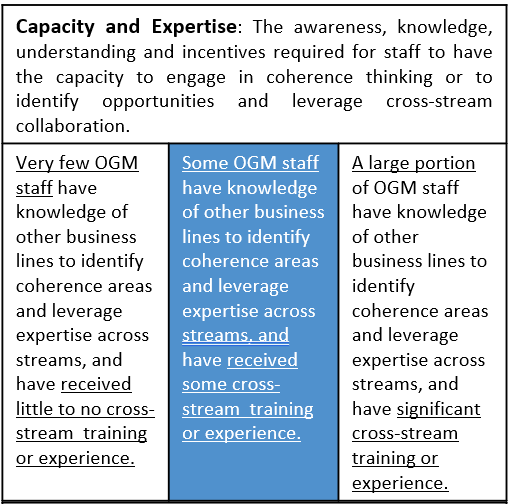
Text version
Presentation of a scorecard: Capacity and Expertise.
Capacity and Expertise: The awareness, knowledge, understanding and incentives required for staff to have the capacity to engage in coherence thinking or to identify opportunities and leverage cross-stream collaboration.
Some OGM staff have knowledge of other business lines to identify coherence areas and leverage expertise across streams, and have received some cross-stream training or experience.
Figure 16:
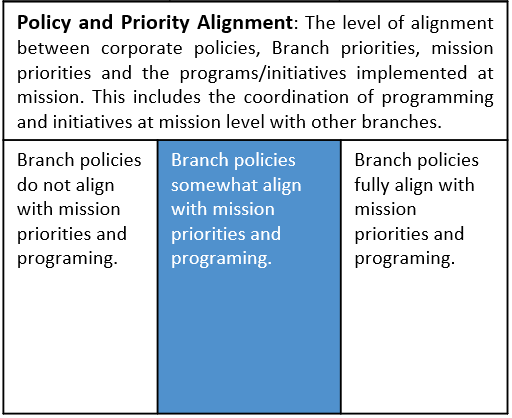
Text version
Presentation of a scorecard: Policy and Priority Alignment.
Policy and Priority Alignment: The level of alignment between corporate policies, Branch priorities, mission priorities and the programs/initiatives implemented at mission. This includes the coordination of programming and initiatives at mission level with other branches.
Branch policies somewhat align with mission priorities and programing.
Annex IV: Evaluation methodology
Figure 17: Principles of Appreciative Inquiry
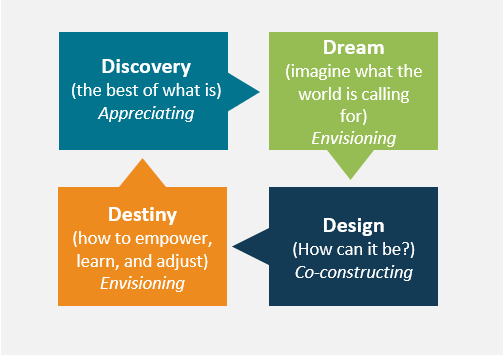
Text version
Illustration outlining the principles of appreciative inquiry:
- Discovery (the best of what is) – Appreciating
- Dream (imagine what the world is calling for – Envisioning
- Design (How can it be?) Co-constructing
- Destiny (how to empower, learn and adjust) - Envisioning
Methodological approach
The evaluation applied Appreciative Inquiry and Goal Free Evaluation methodologies.
Appreciative inquiry
The appreciative inquiry approach was originally conceived as an organizational development and change management approach, as well as a research methodology. It is rooted in positive psychology and aims to enhance organizational development by identifying the best of what is in order to reflect on how to pursue the ideal. It is iterative, continuing to evolve as learning organizations adapt and change. It is based on a 4D model which draws on the principles of appreciative inquiry: Discovery, Dream, Design and Destiny (see Figure 1). Although evaluations take on elements of appreciative inquiry to identify the conditions for success, they also use the organizational framework to provide consistent criteria for identifying factors that enable or impede coherence. Evaluations focus on appreciating what is working well and analyzing why these elements are functioning effectively in order to identify good practices for the department.
Goal-free evaluation
In a goal-free evaluation (GFE), the evaluator conducts the evaluation without reference to predetermined goals and objectives in order to reduce potential goal-related tunnel vision.
A GFE involves observing and measuring outcomes, effects or impacts, whether intended or unintended, without referring to the program’s targets and objectives. A GFE approach includes defining and describing a program by measuring, observing and reviewing literature and documents that deal with program actions and activities, which then leads to an understanding of the outcome measures.
A GFE approach is guided by the following 4 key principles:
- Identify relevant effects to examine without referencing goals and objectives.
- Identify what occurred without the prompting of goals and objectives.
- Determine if what occurred can logically be attributed to the program or intervention.
- Determine the degree to which the effects are positive, negative, or neutral.
Normally, a true GFE would require that the evaluators have no knowledge of the objectives or goals of a program. These principles are applicable to this evaluation because (1) coherence has no universal definition and (2) the goals and objectives of coherence have not been formally defined by the department.
GFE principles allow for a more exploratory approach to analysis and create more space for the emergence of unintended effects. Through a process of measuring and observing the branch’s coherence-related actions and activities, this evaluation approach can contribute to revealing outcome measures.
Annex B – EGM Branch background
Annex V: EGM Branch Financial and Human Resources
Figure 18: Number of FTEs by bureau, 2021-22
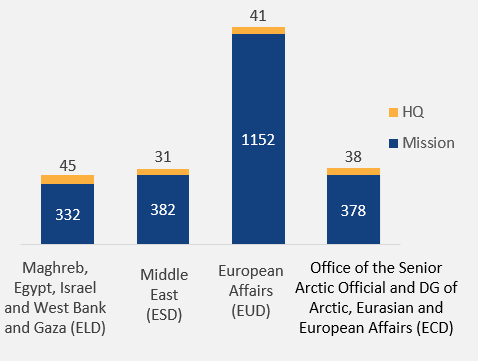
Text version
Maghreb, Egypt, Israel and West Bank and Gaza (ELD)
HQ: 45
Mission: 332
Middle East (ESD)
HQ: 31
Mission: 382
European Affairs (EUD)
HQ: 41
Mission: 1152
Office of the Senior Arctic Official and DG of Arctic, Eurasian and European Affairs (ECD)
HQ: 38
Mission: 378
Figure 19: Proportion of FTEs at mission and headquarters, 2021-22
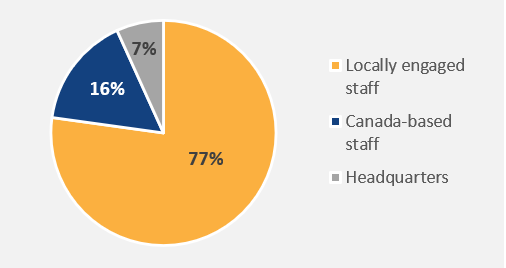
Text version
Locally engaged staff: 77%
Canada-based staff: 16%
Headquarters: 7%
Human Resources
Between 2017-18 and 2021-22, Canada based staff (CBS) full time equivalents (FTEs) increased slightly, showing an increase of 7.5% over the period, from 428 to 460. Information on locally engaged staff (LES) FTEs was only available for 2019-20 and 2021-22, and showed an increase of 6%. The number of CBS and LES combined increased 5% from 2019-20 to 2021-22.
The European Affairs Bureau (EUD) is the largest bureau in the Branch with 1,193 FTEs, including 1152 employees in 26 missions (Figure 2).
Figure 20: EGM Branch Full Time Equivalents
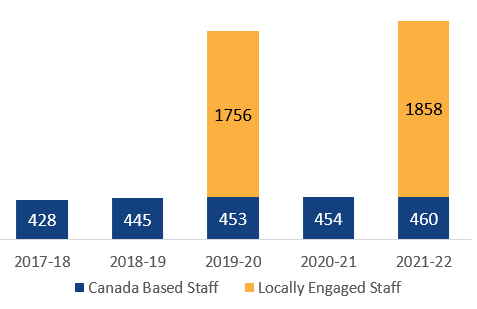
Text version
2017-18
Canada Based Staff: 428
2018-19
Canada Based Staff: 445
2019-20
Canada Based Staff: 453
Locally Engaged Staff: 1,756
2020-21
Canada Based Staff: 454
2021-22
Canada Based Staff: 460
Locally Engaged Staff: 1,858
Note: Data for LES FTEs was only available for one year during the evaluation scope. Data for 2021-22 was included to provide a second data point on LES FTEs.
Financial Resources
The branch financial resources increased between 2017-18 and 2018-19, then remained relatively stable for the remaining three years of the evaluation period. The grants and contributions spending increased by 20% over the period, from $199 Million to $239.7 Million.
Figure 21: Salary and Operation and maintenance, 2017-18 to 2021-22
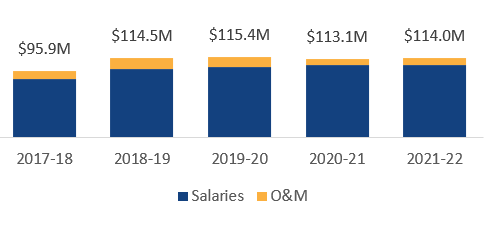
Text version
2017-18
Salaries: $84.2M
O&M: $11.7M
Total: $95.9M
2018-19
Salaries: $99.2M
O&M: $15.2M
Total: $114.5M
2019-20
Salaries: $101.6M
O&M: $13.8M
Total: $115.4M
2020-21
Salaries: $104.7M
O&M: $8.5M
Total: $113.1M
2021-22
Salaries: $103.9M
O&M: $10.1M
Total: $114.0M
Figure 22: Grants and Contributions, 2017-18 to 2021-22
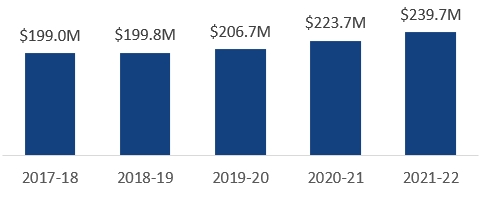
Text version
2017-18: $199.0M
2018-19: $199.8M
2019-20: $206.7M
2020-21: $223.7M
2021-22: $239.7M
Annex C – Case studies
Annex VII: Development and Trade Nexus (Morocco)
Figure 23:
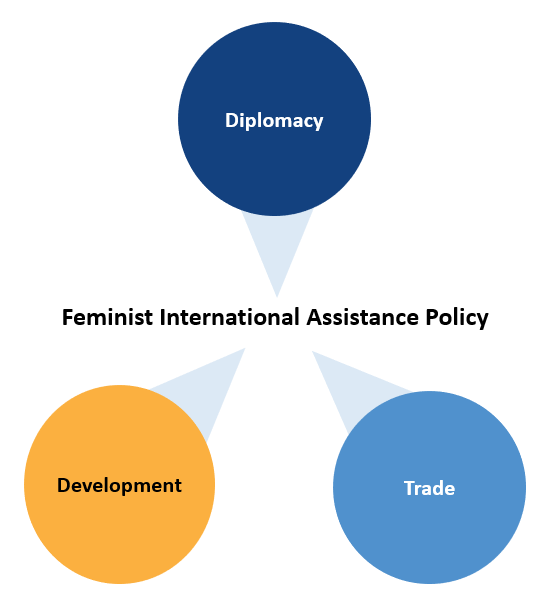
Text version
Development, Trade and Diplomacy working together to support Canada’s Feminist International Assistance Policy.
The Morocco case study demonstrated that the Feminist International Assistance Policy was a major nexus of coherence in the absence of a regional strategy or mandated joint initiative.
Overall, interviews and document review showed that collaboration and coordination across streams were infrequent and largely ad hoc. By and large, the trade and development streams worked separately to achieve and report on their specific objectives. To some extent, the diplomacy stream acted as an agent of coherence by responding to political issues that affected all streams. The unifying factor for coherence was thematically based and involved development, diplomacy and trade all working together to advance gender equality.
The development assistance program led in operationalizing the Feminist International Assistance Policy through its project portfolio, with 67% of investments targeting gender equality and the empowerment of women and girls. The diplomacy stream and the Head of Mission played major roles in interactions advocating for gender equality with the Moroccan government and civil society. The trade stream found novel ways to introduce gender equality into its relationships with the Moroccan private sector and Canadian companies who invest and export to the Moroccan market. In the absence of a unifying policy like the FIAP, very minimal levels of coherence would have been identified by the evaluation.
While staff and managers endeavoured to operationalize coherence and look for ways to collaborate, there was inadequate guidance and direction from the highest levels of the department. A regional strategy mandated joint initiative, incentives and mechanisms for cross-stream collaboration were lacking.
Key achievements of the trade and development nexus at the Morocco mission
The case study identified several achievements in relation to coherence efforts, including:
Advancing gender equality through trade and diplomacy: Trade and the Head of Mission led efforts to encourage Morocco and the Moroccan Minister of Industry, Trade and Green and Digital Economy to sign the Global Arrangement on Trade and Gender. Canada’s credibility and expertise in gender equality were sought by the Moroccan parliament in organizing an event on women’s participation in parliament for the Francophonie. Canada also provided its expertise in gender equality to the Moroccan Minister for Solidarity, Inclusion and the Family in the area of childcare policy to increase women’s participation in the labour force.
The centre of excellence for wheat: The development program funded training for flour millers, whose product sales contributed to the centre’s budget, while trade promoted Canadian wheat exports to Morocco by building relations with the National Federation of Flour Millers and connecting them to Canadian suppliers.
Annex VIII: Triple Nexus (West Bank and Gaza)*
Figure 24:
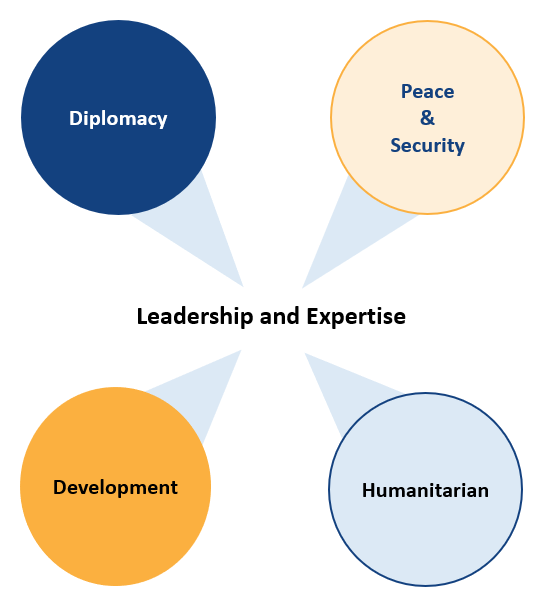
Text version
Leadership and Expertise as primary factors in enabling coherence across Diplomacy, Peace & Security, Development and Humanitarian
* Note that this case study was conducted in March of 2023.
The West Bank and Gaza case study demonstrated that leadership and expertise were primary factors in enabling coherence across business lines.
The Government of Canada’s committed goal of a comprehensive, just and lasting peace in the Middle East through a 2-state solution enabled coherence by providing clear objectives across diplomacy, development, humanitarian, and peace and security. Leadership was able to rely on clear objectives to convey a vision and incentivize cross-stream collaboration, communication and considerations. The Director, Head of Mission and Program Managers were valued as key points of integration.
Cross-stream experience and expertise also enabled coherence. In particular, previous experience of the geographic Director played a significant role in fostering coherence, including their ability to (1) provide a coherent vision and messaging and (2) implement a new strategic planning exercise (5-year country focus) that identified nexus points. Previous experience of the Head of Mission and development and humanitarian program managers also increased coherence. For example, coherence was achieved when staff across streams coordinated with external partners, when joint field visits were carried out and when information and programming were shared and discussed (i.e., gender-based violence projects).
In addition, the $25 million aid package for Palestinians affected by the violence in Gaza and the West Bank was a key factor in facilitating cross-stream collaboration, flexibility and quick program delivery, as was the increased coherence resulting from the unique integration of humanitarian in the geographic region alongside development.
Key coherence achievements in the West Bank and Gaza
The case study identified several achievements in relation to coherence efforts, including the following achievements:
Canadian leadership: Coherence efforts across streams resulted in Global Affairs Canada (GAC) demonstrating effective, strong and capable leadership throughout its engagement in the West Bank and Gaza. GAC was able to demonstrate global leadership by serving as Co-Chair of the Good Humanitarian donor group, with Echo ensuring donor coordination of funding and management.
Messaging to external partners is coherent across streams: Coherence was demonstrated in external communications. For instance, diplomacy and development collaborate on joint campaigns for social media (i.e., 16 posts over 16 days, joint video for International Women’s Day).
- Date modified: